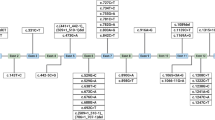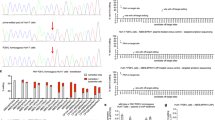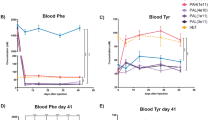Abstract
Genotyping of the phenylalanine hydroxylase (PAH) gene offers a new tool for characterizing patients with phenylketonuria (PKU), refining the diagnosis and aiding in the prediction of the clinical outcome and in the implementation of a more adequate treatment. The primary goal of this work was the detailed study of the different allele combinations and the metabolic phenotypes in Spanish PKU patients in order to understand better the clinical heterogeneity of PAH deficiency in our population. The results show that the disease phenotype is a consequence of a combination of mutations at the PAH locus and this observation is valid throughout the spectrum of clinical and biochemical varieties found in Spanish PKU patients. A stronger correlation was found between the predicted residual activity, when known from previous in vitro studies of the mutant proteins, and the Phe tolerance than between the predicted residual activity and the inverse of Phe levels at diagnosis. The observed genotype-phenotype correlations and the available data on the in vitro residual activity of the mutant proteins has enabled the estimation of the severity of most of the mutations found in Spain. This study includes relevant data for clinicians and pediatricians adding to the present knowledge which relates allelic PAH genotypes to biological phenotypes.
Similar content being viewed by others
Log in or create a free account to read this content
Gain free access to this article, as well as selected content from this journal and more on nature.com
or
References
Scriver CR, Kaufman S, Eisensmith RC, Woo SCL: The hyperphenylalaninemias; in Scriver CR, Beaudet AL, Sly WS, Valle D (eds): The Metabolic and Molecular Bases of Inherited Disease. New York, McGraw-Hill, 1995, pp 1015–1075.
Güttler F, Guldberg P: The influence of mutations on enzyme activity and phenylalanine tolerance in phenylalanine hydroxylase deficiency. Eur J Pediatr 1996;155(suppl 1):6–10.
Okano Y, Eisensmith RC, Güttier F, Lichter-Konecki U, Konecki DS, Trefz FK, Dasovich M, Wang T, Kenriksen K, Lou H, Woo SLC: Molecular basis of phenotypic heterogeneity in phenylketonuria. N Engl J Med 1991;324: 1232–1238.
Svensson E, von Döbeln U, Eisensmith RC, Hagenfeldt L, Woo SLC: Relation between genotype and phenotype in Swedish phenylketonuria and hyperphenylalaninemia patients. Eur J Pediatr 1993;152:132–139.
Scriver CR, Delente JJ, Elkas G, Carter K, Lambert M, Waters P, Treacy EP: L-[113C]-Phenylalanine oxidation in hyperphenylalaninemia (HPA): Analysis of genotype/phenotype correlations (abstract). Am J Hum Genet 1996; 59(suppl):68.
Pérez B, Desviat LR, Ugarte M: Analysis of the phenylalanine hydroxylase gene in the Spanish population: Mutation profile and association with intragenic polymorphic markers. Am J Hum Genet 1997;60:95–102.
McCaman MW, Robins E: Fluorometric method for the determination of phenylalanine from serum. J Lab Clin Med 1962;59:885–890.
John SWM, Weitzner G, Rozen R, Sciver CR: A rapid procedure for extracting genomic DNA from leukocytes. Nucleic Acids Res 1991; 19: 408.
Guldberg P, Güttier F: ‘Broad-range’ DGGE for single-step mutation scanning of entire genes: Application to human phenylalanine hydroxylase gene. Nucleic Acids Res 1993;22: 880–881.
Hoang L, Byck S, Prevost L, Scriver CR: PAH Mutation Analysis Consortium Database: A database for disease-producing and other allelic variations at the human PAH locus. Nucleic Acids Res 1996;24:127–131.
Desviat LR, Pérez B, Ugarte M: Analysis by illegitimate transcription of a mutation in the 5′ splice site in exon 8 of the PAH gene (abstract). Am J Hum Genet 1994;55(suppl): 2098.
Eisensmith RC, Martinez DR, Kuzmin AI, Goltsov AA, Brown A, Singh R, Elsas LJ, Woo SLC: Molecular basis of phenylketonuria and a correlation between genotype and phenotype in a heterogeneous southeastern US population. Pediatrics 1995;97:512–516.
Guldberg P, Henriksen KF, Thony B, Blau N, Güttier F: Molecular heterogeneity of non-phe-nylketonuria hyperphenylalaninemia in 25 Danish patients. Genomics 1994;21:453–455.
Zschocke J, Graham CA, Stewart FJ, Carson DJ, Nevin NC: Non-phenylketonuria hyperphenylalaninemia in Northern Ireland: Frequent mutation allows screening and early diagnosis. Hum Mutat 1994;4:114–118.
Ramus SJ, Forrest SM, Pitt DB, Saleeba JA, Cotton RGH: Comparison of genotype and intellectual phenotype in untreated PKU patients. J Med Genet 1993;30:401–405.
Dworniczack B, Aulehla-Scholz C, Kalaydjieva L, Bartholomé K, Grudda K, Horst J: Aberrant splicing of phenylalanine hydroxylase mRNA: The major cause of phenylketonuria in parts of southern Europe. Genomics 1991; 11:242–246.
Desviat LR, Pérez B, Ugarte M: Molecular basis of non-PKU hyperphenylalaninemia in Spain: Prevalence of A403V, a mutation with high residual activity. J Inherit Metab Dis 1996;19:227–230.
Romano V, Guldberg P, Güttier F, Meli C, Mollica F, Pavone L, Giovannini M, Riva E, Biasucci G, Luotti D, Palillo L, Cali F, Ceratto N, Anello G, Bosco P: PAH deficiency in Italy: Correlation of genotype with phenotype in the Sicilian population. J Inherit Metab Dis 1996; 19:15–24.
Acknowledgements
The authors wish to thank A. Sánchez for her excellent technical assistance and L. Pérez for her help with the statistical analysis. This work was supported by a grant from the Comunidad Autonoma de Madrid (Acción Coordinada 010). The institutional grant of ‘Fundación Ramón Areces’ to the Centro de Biología Molecular ‘Severo Ochoa’ is gratefully acknowledged.
Author information
Authors and Affiliations
Corresponding author
Rights and permissions
About this article
Cite this article
Desviat, L.R., Pérez, B., García, M.J. et al. Relationship between Mutation Genotype and Biochemical Phenotype in a Heterogeneous Spanish Phenylketonuria Population. Eur J Hum Genet 5, 196–202 (1997). https://doi.org/10.1007/BF03405917
Received:
Revised:
Accepted:
Issue date:
DOI: https://doi.org/10.1007/BF03405917



